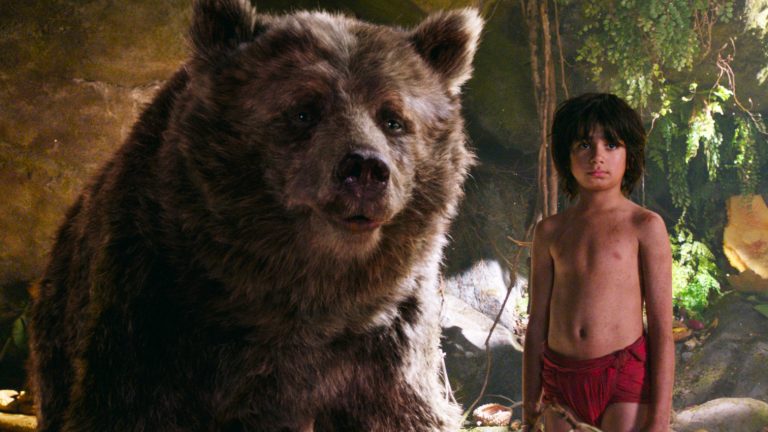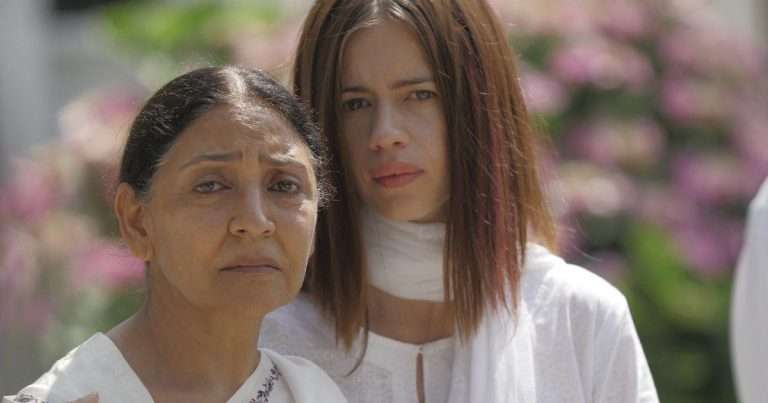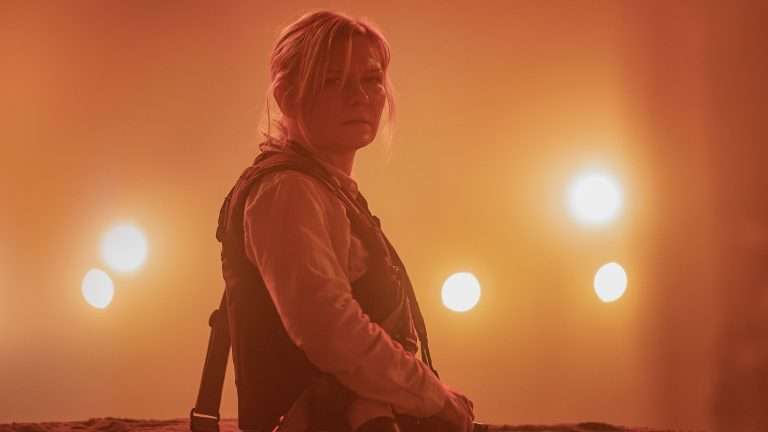Anthropomorphism has always fascinated me beyond comparison. Our endeavor to humanize even our most insentient creations is endearing, to say the least. Love can be taught, fostered, and experienced in ways we aren’t always capable of comprehending. It’s presumably why we gave the headlights of our cars a resemblance to human eyes, called our boats by precious first names, and affixed smiley faces onto our androids.
Chris Sanders’ adaptation of Peter Brown’s novel, “The Wild Robot” (2024) understands the love that transcends above what we created and what created us. It bears no sci-fi malice but daringly envisions a utopic promising future wherein nature and technology coexist synergistically, driven by mutual affection rather than adversarial dynamics.
Sanders accentuates that survival isn’t a solitary ordeal and we are hardwired to seek connection. The concept of a “Found Family” or a chosen family also often resonates with fragmented and socially discarded groups like the LGBTQIA+ community which reiterates that unconditional love and family can take varied forms and definitions. “The Wild Robot” thus attempts to illustrate how love often compels us to discard our core belief systems and transcend personal biases or conditioning to offer the unconditional acceptance that we also seek.
The film commences in the pristine lap of a small island in the Pacific. Rozzum 7134, a helper robot aka Roz (voiced by Lupita Nyong’o) finds herself in the swings and throes of an untamed ecosystem whose order she doesn’t quite understand. DreamWorks artfully employs its remarkable vision by juxtaposing the cold, grey, and mechanical Roz against the fluid, painterly textures of the jungle, strengthening the film’s fixation on coexistence. The forest she finds herself in is stunning and full of character, saturated in vivid greens and blues yet never overpowering— creating a superlative attempt at assembling “A Monet painting in a Miyazaki forest.”
Despite being primarily programmed to assist humans in their everyday chores, she is quick to realize that her only chance at survival is to learn to belong to the wild. She quickly resorts to observing & mimicking the fauna of the forest to navigate the tumultuous terrain. By staying true to her principle “Kindness is a survival skill”, Roz carves out a place for herself, not through brute force but through compassion. Her attempts at being amalgamated into the forest community while sticking to her ideals subvert the expectations of her docile robotic identity. Through this transgressive process, the idea of a “found family” begins to take shape.
“But sometimes to survive, we need to become more than we were programmed to be”
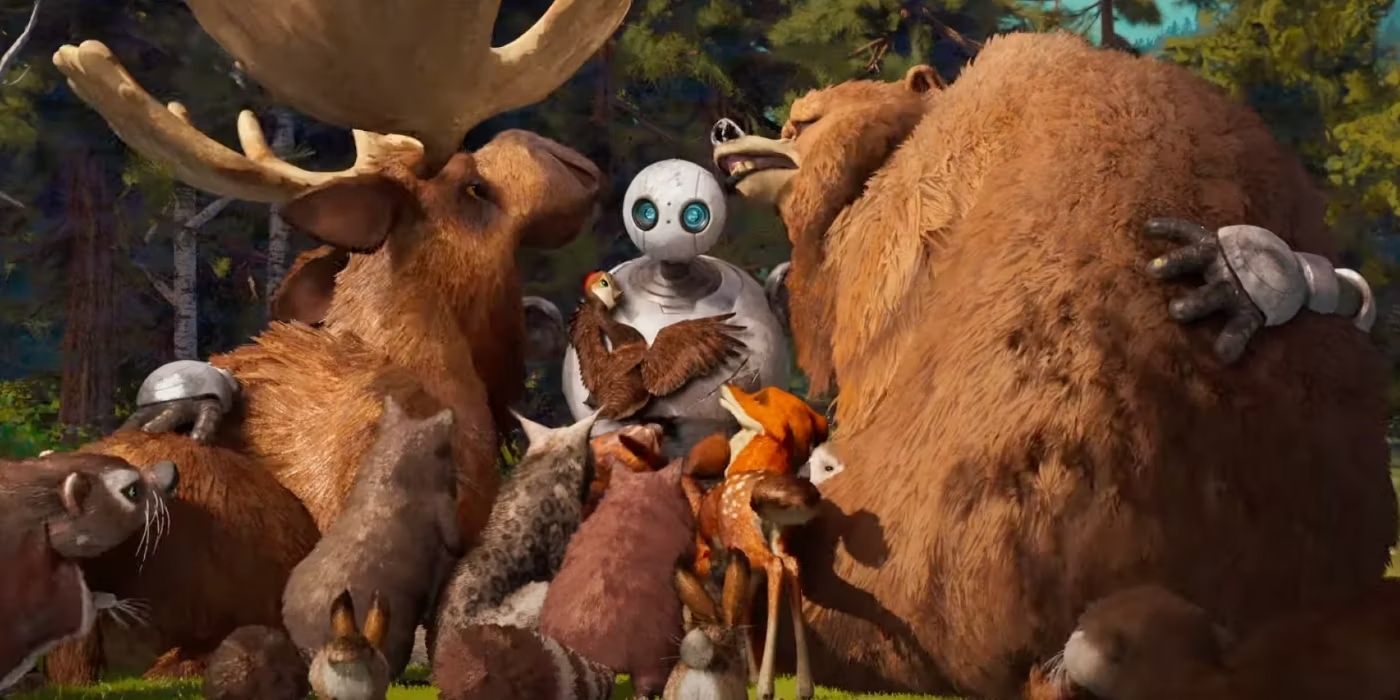
Motherhood and parental responsibilities aren’t Roz’s cup of tea. Upon finding herself crashed atop a bird nest with a single surviving egg, she protectively salvages it from Fink, the fox (voiced by Pedro Pascal). Unlike her automation, it was a task that nobody assigned but an unbeknownst instinct she seemed to have acquired from the jungle. She reprograms herself against her dispositions and gains the ability to access something more akin to human empathy.
Roz challenges the preconceived ideas about what makes a parent and sets out on the task of teaching Brightbill (voiced by Kit Connor) self-sufficiency. “The Wild Robot” is a homage to well-meaning yet lost parents navigating the challenges of raising children, as well as to the village it takes to do so. Pinktail, the opossum (voiced by Catherine O’Hara) is a fellow reassuring mother, who eases Roz about her parenting and that we all make it up as we go.
Familial connections are not intrinsically tied to blood or in this case, even flesh, but can be formed through acts of kindness and sharing reciprocal experiences. Fink, a fellow outcast, claims, “I’m a fox, I do foxy things, It’s in my nature”, yet evolves against all of his manipulative carnal instincts to protect the gosling Brightbill and guide Roz in raising him right.
Sanders employs Roz, Fink & Brightbill’s striking interpersonal dynamics to pose broader questions about what it means to be human (or humane) and how the capacity for love and empathy transcends natural or biological design. A relentless robot with outstretched arms teaching a gosling how to fly, over a Maren Morris song is all you need to ensure not a single dry eye in the room. Roz represents countless mothers of children who don’t fit in. Brightbill’s expedition towards autonomy is a reminder of a parent’s most critical role—which, unlike Roz’s assumed idea of tasks, is never truly finished.
“When you grow up without something, you spend a lot of time thinking about it.”
Love and home are foreign to both Brightbill and Roz bestowed with similar fates— waking up to their supposed families dead beside them. They bonded over being odd, thus fostering a cocoon of belonging within a hostile jungle. “The Wild Robot” doesn’t shy away from addressing themes like death and rejection from the community. Emotional moments in the film are genuinely deserved, not forced. Roz displays relentless kindness towards a community that deeply rejects her, Brightbill, and Fink. Roz’s status as a foreigner is a continuous tension. Her eventual acceptance is hard-earned and articulates the arduous negotiations that result in building a chosen family.
It isn’t merely that they become cordial with her over time; they all must first confound their instincts, suspicions, and prejudices. Sanders avoids glorifying this by showing that found families, like biological ones, are created through struggle, misapprehensions, and the gradual building of faith.
The scene wherein an almost-frigid Roz struggles to retrieve every animal out of the winter storm into her home is intensely memorable. Despite its unforgivingness, nature has an incredible ability to restore equilibrium. Thus, Roz learns to adapt and finds herself constantly self-assigning tasks that aren’t written in her programming as unintended acts of friendship and sacrifice.
Universal Dynamics, the company that built Roz, makes several attempts to violently retrieve her. However, with the assistance of Paddler, the beaver (voiced by Matt Berry), the animals save their ablaze forest from the aftermath of the attack. Together, they confront the wrath of nature & technology alike— not only surviving but thriving in the face of adversity.
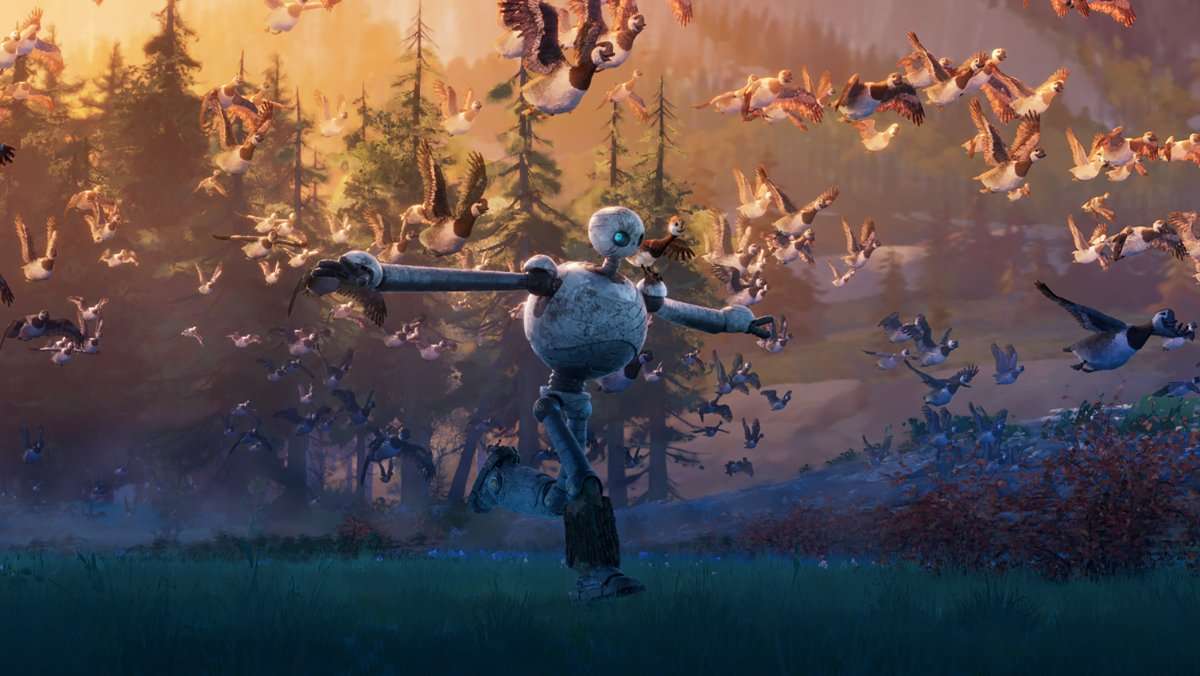
“I forgot to tell her something”
“That’s okay, sometimes the hearts do all the talking”
In moments of separation and grief, this film adapts a very sophisticated approach to foster indomitable faith and to believe that connections built cordially can never be severed. What makes it truly exceptional is its sharp, thoughtfully crafted script. Every line carries significance, blending humor based on misfortune with circumstantial sincerity. “The Wild Robot” harmoniously balances reflective moments with exciting chase sequences. Every single character, whether it is the forest itself, the animals, people, or robots, is fully realized and celebrated on screen.
“The Wild Robot” is embellished with many complex themes including the co-existence of Nurture and Nature to survive and make decisions from the heart instead of our pre-programmed conditioned instincts. It reflects upon the isolation caused by withdrawal from the community for being different.
It also demonstrates that trust, determination, and compassion can empower even the most unanticipated individuals to take the lead. Roz acquired several skills from her Found Family— learning how to leap from a gazelle, climbing a mountain by observing a crab, playing the dead-possum trick to escape being taken away by Universal Dynamics, and lastly, camaraderie from Fink, Pinktail & the other animals.
“This is wilderness…and I am a wild robot”
Roz becomes one with her chosen home and family— a moss-covered robot with an affixed wooden leg. In the final act, the film demonstrates the significance of staying true to oneself in a world that imposes & rewards conformity. As we observe Roz, Fink, and Brightbill navigate life, we are compelled to think about the unlikely affinities that can form in the most unforeseen circumstances. “The Wild Robot” debases the typical portrait of robots as detrimental or domineering, instead offering a moving narrative where they are thoughtfully designed for kindness and empathy.
This divergence from the customary “robotic threat” trope not only humanizes the machines but also enables a more nuanced outlook of artificial intelligence as capable of compassion rather than supremacy. In a world that depends on technology but often sees it as cold and emotionless, “The Wild Robot” encourages one to broaden their perspectives, modes, and definitions of love.





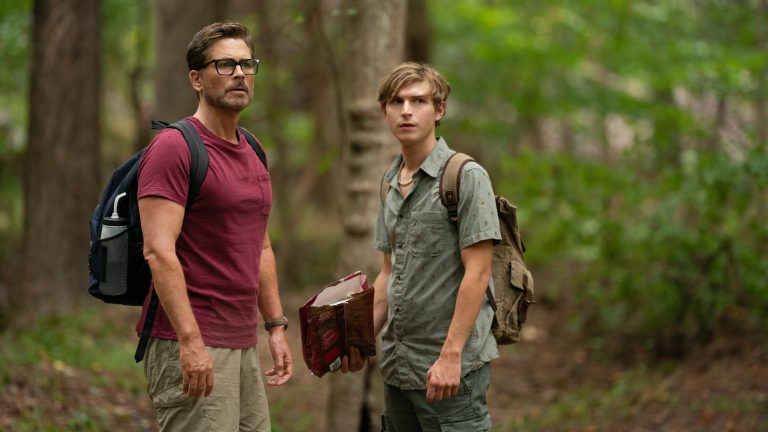
![The Master [2012] : A Kaleidoscope of Meaning](https://79468c92.delivery.rocketcdn.me/wp-content/uploads/2017/01/The-Master-768x512.jpeg)
